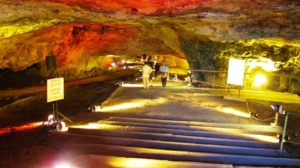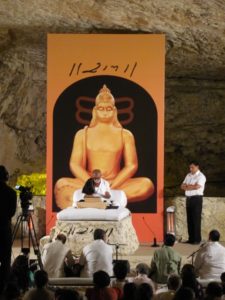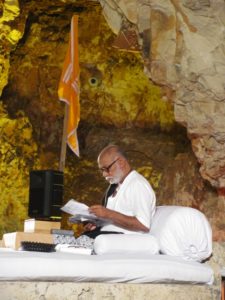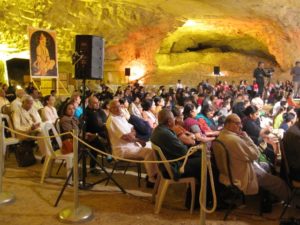I would like to thank Pamela Salomon Benner for editing the English translation of this post
Outside the walls of the Old City of Jerusalem and east of Damascus Gate is a small green door. If you stand in front of it, you cannot imagine what lies on the other side. If you pass through that door, you will find a huge underground cave 300 meters long and 100 meters wide. The place was once a subterranean quarry used by the builders of Jerusalem in the Second Temple period. A persistent tradition says that King Solomon used stones from the same quarry to build the First Temple. The cave is linked to many traditions, and quite a few stories exist about it. The children of Jerusalem would tell you, for example, that this was the place where the Bible says Korach and his followers disappeared after the earth opened its mouth and swallowed them.
The most important tradition concerns King Zedekiah, the last king of Judea. According to Jeremiah 52, Zedekiah tried to escape from the city of Jerusalem while it was under siege. He managed to flee through a place referenced as the “gate between the two walls,” but “… the army of the Chaldeans pursued the king, and they overtook Zedekiah on the plains of Jericho, and all his army had scattered and deserted him….” (Jeremiah 52:8). Zedekiah was led to Babylon, but not before the Chaldeans killed his sons in front of him and then blinded him. He spent the rest of his life in exile, away from his city and country.
Now you probably asked yourself, “How did King Zedekiah get from ‘between the two walls’ to the plains of Jericho while the city of Jerusalem was under siege?” Well, the book of Jeremiah does not tell us anything about that; however, Rashi does supply us with an answer: “He [Zedekiah] had a cave going from his house to the plains of Jericho and he escaped through the cave. What did God Almighty do? He presented a deer to the Chaldeans and made it run above the cave’s roof. The Chaldeans chased the deer and as Zedekiah emerged from the other side of the cave, they spotted him and caught him.” You can easily guess the end of my story: An old tradition made the connection between the cave Rashi wrote about and the cave found near Damascus Gate. At the heart of the cave lies a small spring, and it is believed that its water comes from King Zedekiah’s tears—the tears he shed while watching the death of his sonsand the destruction of his city.
The only entrance to the cave was once barricaded by Sultan Suleiman I who feared while he was building the walls of the Old City that the cave might serve as a weak spot during a siege. For many years people told tales about a huge cave residing under the Muslim Quarter of the Old City of Jerusalem, but the cave was found again only during the 1850s by James Turner Barclay. Barclay, who was a doctor and a Bible scholar, walked his dog one night outside the walls of the Old City. Suddenly the dog disappeared. It took Barclay a while until he found the dog barking from inside a hole in the ground. The hole led Barclay and his colleagues down to the heart of the earth and thus they discovered Zedekiah’s Cave again. Barclay was followed by interested Freemasons, who thought this was the quarry of King Solomon, the first Freemason according to their tradition. Freemasons continue to assemble secretly in the cave every once in a while.
Over the past few years the cave of Zedekiah has been open to all visitors. As a tour guide I take many of my groups to see this fantastic site. On a hot day in May 2012 we walked into the cave, trying to escape the blazing sun, and I was telling my group about various traditions related to the cave of Zedekiah. Nothing prepared us for the surprise that was waiting for us inside. All around we saw loudspeakers from which a soft, wonderful Indian singing voice emerged. At first I thought it was a new tourist upgrade intended to make our stay underground more pleasant; however, after walking farther into the cave we discovered the true nature of the music. At the great hall in the center of the cave sat hundreds if not thousands of Indians. In front of them, on a small improvised stage with the image of the god Hanuman in the background, sat the guru Sri Morari Bapu telling the tales of Rama, Sita and Hanuman in Lanka as they are told in the Indian epic Ramayana.
Sri Morari Bapu, a well-known guru in India, is particularly respected as a preacher who conducts special ceremonial readings of and commentaries on the sacred Hindu writings. These ceremonies are called kathe and last nine or ten days each. The readings are accompanied by traditional Indian music played live by Indian masters of traditional Indian instruments. This scene explained the music we heard when we entered the cave.
Sri Morari Bapu lives in the small village of Talgajarda in Bhavnagar, a district in the state of Gujarat, India. From his base he travels worldwide to perform nine-day kathe. As of this writing Sri Morari Bapu has performed at least 700 kathe around the world on land, at sea and even on air. The kathe are attended by huge crowds—sometimes thousands, sometimes millions.
This was Sri Morari Bapu’s first tour in Jerusalem. On his Web site he wrote that Jerusalem is an example of a small city where people of all religions learned to live together and didn’t have to compromise over their religion. The followers of Sri Morari Bapu with whom we spoke told us that in his katha he emphasized the need for compassion, love and reconciliation and thus, according to their belief, it is obvious that Jerusalem is a legitimate site for this kind of ceremony. They considered the katha in Jerusalem as a means to send a message to the entire world.
The sitar was playing, Sri Morari Bapu led the ceremony on, and the excited crowd sat quietly and observed every word. I led my group farther into the depths of the cave. As we returned to the main hall half an hour later it seemed as though nothing had changed. The guru maintained the same position, as did his followers. No one was in a rush. I thought to myself that they had all come to Zedekiah’s Cave to find their way into the heart of Jerusalem. Later, another thought occurred to me: Could it be that Sri Morari Bapu had transformed Zedekiah’s Cave from a way to escape from Jerusalem to a gateway into the city? Could he see in a place that symbolizes the destruction of the city the way to rebuild it? Could it be that through the stone that helped build the city two thousand years ago Sri Morari Bapu built a bridge between the hearts of all lovers of Jerusalem? Was this what Sri Morari Bapu intended, or was it my own wild imagination? I suppose I will eventually find the solution while touring Jerusalem.…
A short video I took in the cave



